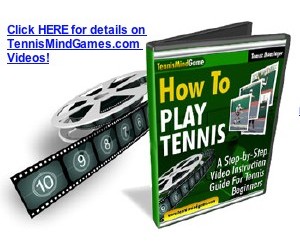October 2007 Article Wild Cards Archives:
Tennis Server
|

 |
by Jane Voigt
For the millions of tennis fans who couldn’t make it to Arthur Ashe Stadium during the two weeks of the U.S. Open, the alternative route to the Grand Slam action was television. If you listened carefully, expert commentators such as Patrick McEnroe, John McEnroe, Tracy Austin, and even Andre Agassi offered a peek into what goes through players’ minds, as they battled through the draws. Fans at home could hear the inner game of tennis and apply it to friendly games played in any neighborhood across America. "If you want to compete with the big guys out here, you have to hit out and go for your shots," Patrick McEnroe recalled telling wildcard Donald Young, at a recent Davis Cup Tie. "You can’t be pushing the ball around." The American junior Donald Young needed this coaching because he needed more than quickness against Chris Guccione, an older seasoned giant of a man from Australia. In that small anecdote, Patrick gave away one of the biggest tips in top-level tennis. Michael Barcan confirmed Patrick’s insight as he interviewed player after player in the tunnel that lead to center court of Arthur Ashe Stadium. "What are you going to do to win," Michael asked. No matter who it was, they said, "I’m going to go for my shots," "Hold my serve," and "Keep my feet moving." Jimmy Connors told Andy Roddick, "Go out there and hit the ball," before his match against the Swede Thomas Johansson. Andy executed brilliantly, serving with speed and precision, slapping razor-sharp forehands and winning the match in three quick sets. Who couldn’t put these suggestions to their own use? Pass the potato chips, please. During one difficult point between Anna Chakvetadze and Tamira Paszek, Tracy Austin relayed to viewers how Paszek won her one game of the first set. "Paszek lost the ball in the lights, at first," Tracy began, "but she adjusted her feet and put the ball back in play. Because of that Anna had to hit one more ball, which went out. Tamirna won that game because of those quick adjustments in her feet." Everyone at home who had fumbled with footwork on a tennis court could relate instantly to Austin’s seasoned observation. Tracy brought it all to life as her keen tennis sense revealed another tasty tidbit of the game. Similarly, during the fifth-set thriller between American James Blake and Tommy Haas, Johnny Mac remarked, "Blake was lucky to get that ball back, but he made Tommy hit one more ball." It made perfect sense. Since the aim of the game is to be the last person who gets the ball over the net successfully, then make your opponent hit one more ball. Mary Jo Fernandez asked Tommy Haas how he pulled out the win. "I had to stay calm and fight for every point," Haas told the thousands in Ashe Stadium. His message was a simple and powerful reminder for club players. "If you want to be in the top ten of men’s tennis today, you have to have a great serve," McEnroe said, during the third-round match between the Frenchman Jo-Wilfried Tsonga and the second seed Raphael Nadal. He continued, "A good service motion is very similar to a throwing motion." Here was an insight for the ages. What wannabe tennis star couldn’t just walk out their front door and practice throwing a ball? By throwing the racquet up at the ball the next time on court you could create a monumental change in your tennis game. A solution was at hand for anyone’s floundering serve— if they sat at home and paid attention. As Novak Djokovic served for the match in the fourth set thriller against Argentine Juan Monaco, John McEnroe commented on a key champion characteristic, "You have to hang in there." That’s exactly what Novak did, battling fatigue, mounting errors, and an opponent that seemingly wouldn’t go away. We’ve all seen how the effects of frustration, anger, or, at the extreme, a broken racquet could turn around a friendly match. Here was the answer to preventing those emotional hitches from dragging a player down… just keep going. Andre Agassi’s technical commentary, the evening of the Roddick/Federer match, could have motivated at-home viewers to grab their racquets and immediately head for the nearest court. Agassi had played Roddick. He had played Federer. His visceral experiences enlivened the commentary and the match at hand beyond viewers’ dreams. In one instance, Andre seemed to put Ted Robinson in his seat, after being asked if he had tried to engage an audience in his matches the way Roddick looked to be egging on the audience. "No, I didn’t do that. I watched the ball and moved my feet. Speed is the most underrated weapon in sports." So there! Andre gave listeners so much tactical and practical tennis information that every print and broadcast journalists, along with bloggers alike, wrote about the occasion. His presence and common-sense comments that seemed so obvious when uttered made it to the pages of the New York Times as well as the chat rooms of Tennis.com. "Don’t let the score influence your technique," Andre said calmly. "Watch how Roger keeps his head down and swings through his shot," Andre noticed. All those photographs of the Swiss tennis king, as he hit a forehand with his eyes fixed on the ball, were instantly confirmed when Agassi brought it to the foreground of the commentary. "Swing out on your shots," he said. "Move in when you get the opportunities," he confirmed, as we watched Federer dart to the service line, making quick work out of a short shot from the failing Roddick. Viewers needed a pad and pen to keep up with these pearls of wisdom. "I could tell where Becker’s serves would go by the position of his tongue," Andre began, after the conversation segued to anticipating serves. "Boris would always have his tongue sticking out between his lips. I knew where he’d go by the position of his tongue. If it were out to the left he would slice. If it were out to the right he would hit a kicker. If it was centered, he was coming straight in." Johnny Mac laughed. "You have got to be kidding," he said, incredulously and echoing sentiments of his own past on-court confrontations with chair umpires. "Tell us you’re making this up." Agassi stuck with his story; and, USA’s research department never came through with any historic proof that either confirmed or denied the assertion. No doubt, some experiences were missed without a trip to the Open. The round sound of a ball hitting the strings, or the quiet brush of a slice serve or extreme topspin return couldn’t be detected from home. Seeing neon yellow fuzz fly off a tennis ball that had been whacked by a top-100 player was imperceptible, too, even with high definition brilliance. The smells went missing, too. An instant fluttering of cologne or perfume from passersby, or the hint of Coppertone sunscreen lotion that would evoke remembrances of trips to the beach couldn’t be reproduced. The pace of the ball was subdued, too, unless the camera took viewers court level where the speed and grind came alive. In an interview, Roger Federer spoke about his first set loss to the lefty Spaniard Feliciano Lopez. "Don’t panic," he said, imparting pearls of wisdom that when pondered seem simple but contain infinite applications for the masses. His answer was perfectly Roger. He doesn’t panic during a match. He remains calm in direct contrast to those he punishes with precise angles off his forehand, service aces when down a break point or two, and up-the-line backhand flicks. And, to the cheers of a full house at Arthur Ashe Stadium, Roger didn’t panic as he defeated Novak Djokovic in straight sets to win the U.S. Open crown once again. If you wish to provide a comment to the author of this Wild Cards column, please use this form. Tennis Server will forward the comment to the author.
1998 - 2003 | 2004 - Present
This column is copyrighted by the author, all rights reserved.
|



October 2022 Tennis Anyone: Patterns in Doubles by John Mills. September 2022 Tennis Anyone: Short Court by John Mills. |
 You will join 13,000 other subscribers in receiving news of updates to the Tennis Server along with monthly tennis tips from tennis pro Tom Veneziano.
You will join 13,000 other subscribers in receiving news of updates to the Tennis Server along with monthly tennis tips from tennis pro Tom Veneziano. 
